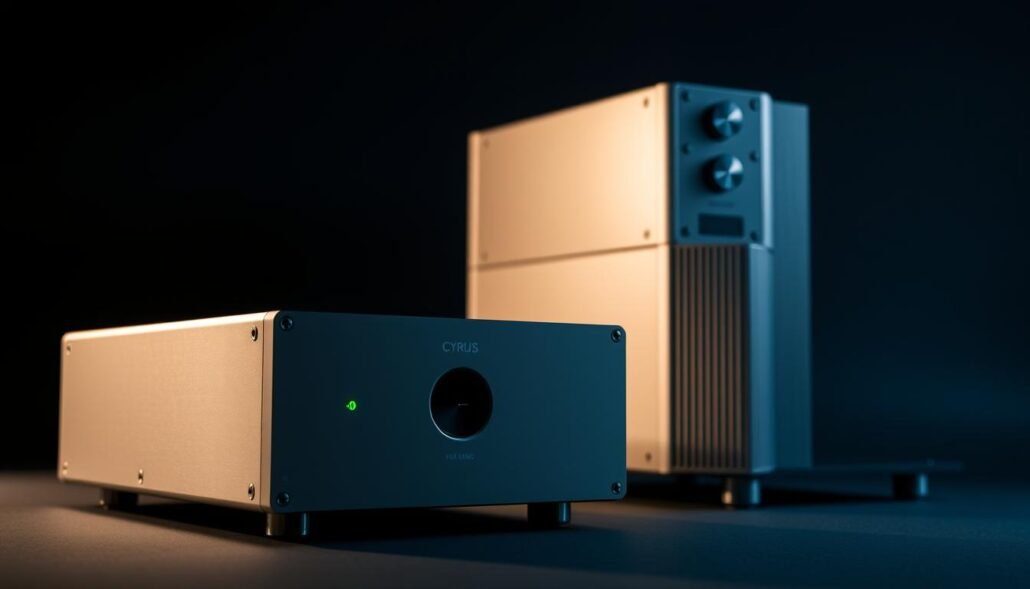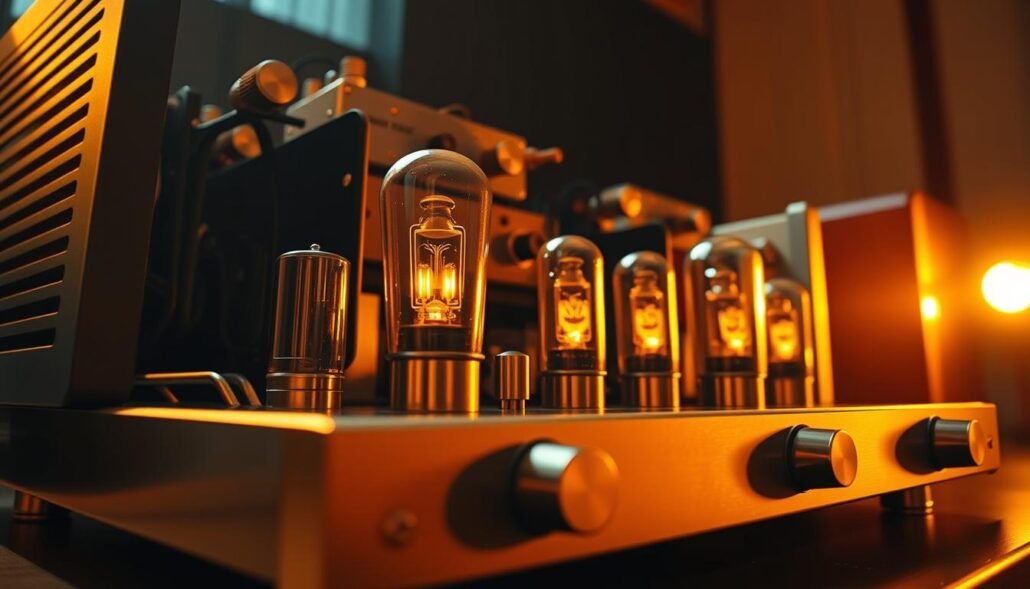Ready to pick an amp that truly fits your vinyl-first setup? This short guide distills a hands-on review of four integrated models tested with a Linn Majik LP12, ProAc D2R speakers, and Chord Epic X cabling. You’ll get clear takeaways on sound, power delivery, and which features matter most for real rooms.
We listened across Mozart, Prince, and Britten to reveal practical differences: sweetness and balance, sheer transparency, musical drive, and an all-round tuned presentation. The write-up ties those impressions to class and topology so you can judge volume headroom and speaker control.
Expect plain-English guidance on which units include a DAC, which keep the signal purely analog, and how onboard phono stages affect a vinyl system. By the end you’ll have a fast shortlist and tips for confident auditioning rather than wading through long reviews.
Bel Canto C6i vs Naim Supernait 3: smooth sweetness or punchy precision?
Side-by-side listening makes it clear which design favours lyric warmth and which pushes rhythmic drive.
Sound signature and music genres. The Bel Canto C6i leans toward a sweet, airy treble and roomy presentation that flatters strings and hall ambience. It invites long sessions with orchestral and acoustic music. The Naim Supernait 3 trades some of that sweetness for tauter structure and muscular timing. It tightens complex mixes so rhythm and detail pop.
Power, dynamics, and studio tracks
The Naim shows its mettle on studio-produced material like Purple Rain. Bass lines arrive with form and force, and transients stay crisp. The C6i keeps vocals warm and forgiving but offers less slam.
Phono stage and DAC choices
Feature note: C6i integrates a DAC for easy digital hookup. Supernait 3 is analog-first with an MM phono stage, ideal if you favour a pure signal path or plan a separate DAC upgrade.
Speaker pairing and room size
Match the C6i to transparent monitors and small-to-medium rooms for bloom and air. Match the Naim to speakers that need firm woofer control and medium-to-large rooms when you want authority and drive.
- If you want lyrical warmth: C6i.
- If you want punch and propulsion: Supernait 3.
Cyrus i9-XR vs Moon 340iX: detail-first transparency or balanced all-rounder?
Two very different engineering philosophies showed up when we cued the same tracks through the Cyrus and Moon units.
The Cyrus i9-XR delivered a fresh, airy stage with fast, clean bass and highly revealing treble. Its detail-first design makes strings and acoustic textures feel alive. That analytical top end helps uncover reverb tails and micro-details in studio work.
The Moon 340iX leaned more toward a warm, balanced voice. It married sweetness with tidy timing and solid low-end punch. On Mozart the Moon set the orchestra slightly back and kept woodwinds rich. On Purple Rain it added structure and depth without over-shining cymbals.

Practical notes: power, features and pairing
Power delivery felt authoritative on both; the Moon gives a touch more weight, the Cyrus more speed. The i9-XR includes a built-in dac for everyday ease. The Moon tested had optional MM/MC phono and DAC installed for vinyl lovers.
- If you want transparency: Cyrus rewards critical listening and surgical detail.
- If you want a do-everything amp: Moon’s balance suits varied playlists and most speakers.
Amplifier comparison essentials: power, class, and design choices that shape sound
Power ratings are only a starting point. Current delivery and supply stiffness tell you how an amp controls woofers and keeps dynamics alive at listening levels.
Class and topology shape tone and feel. Biasing, feedback, and output devices make a unit sound sweet, taut, or neutral. That explains why the Bel Canto sounded airy while the Naim felt driving and disciplined.
Feature layout matters too. The Supernait 3 is analog-only for users who want separate digital upgrades. The Bel Canto C6i and Cyrus i9-XR include DACs for simpler setups. The Moon 340iX accepts D3PX modules for phono and DAC options.
- Voicing: transparency, warmth, balance, or punch emerge from design choices.
- Architecture: affects noise floor, microdynamics, and long-term reliability.
- Pick by priority: timing and drive, treble refinement, or one-box convenience.
| Model | Digital | Voicing | Best fit |
|---|---|---|---|
| Bel Canto C6i | Built-in DAC | Sweet, airy | Transparent speakers, small rooms |
| Naim Supernait 3 | Analog-only | Structured, driving | Speakers needing control, larger rooms |
| Cyrus i9-XR | Built-in DAC | Detail-first, fast | Critical listening, revealing speakers |
| Moon 340iX (D3PX) | Optional DAC/MM‑MC | Balanced, warm | All-round use, upgradeable |
Tube, solid-state, and Class D at a glance: which amplification path fits your music and studio?
Different power technologies change how a record or mix feels in your room. This quick guide helps you pick a path that matches your tastes and work needs.

Warmth and harmonics of tube gear
Tubes like EL84, 6V6, and 5881 are prized for warm midrange and engaging harmonics. They make vocals and acoustic instruments sound intimate and emotionally convincing.
Note: higher-power types such as 7591 and EL34 appear in louder designs or guitar-focused rigs. Expect a softer attack and lush bloom, and budget time and money for tube rolling and upkeep.
Clean slam from solid-state
Well-executed AB and similar topologies deliver tight transients, low noise, and strong damping. That translates to crisp bass grip and reliable, set-and-forget operation for everyday listening.
Modern Class D modules: efficient and punchy
Today’s Class D ecosystems—GaN, Hypex, and Pascal—offer high power from compact chassis with low heat. They give excellent speaker control and suit studios and long sessions where endurance matters.
- Tube: organic bloom and harmonic richness.
- Solid-state: punch, linearity, and low noise.
- Class D: efficient power, compact size, and control.
Audition with albums you know. Your ears will decide which class of amplification makes your favorite tracks feel most alive by the end of the session.
Specs that matter when buying: power, input options, DACs, and speaker matching
Before you buy, focus on the specs that actually change what you hear in your room.
Rated watts, current delivery, and impedance for real speakers
Rated power is a headline number. Current delivery and supply stiffness decide how an amp controls driver motion under load.
Match nominal and minimum impedance to keep bass defined when the music gets demanding. Two units with similar watt ratings can feel very different into tough speaker loads.
Phono stages, line inputs, and DAC quality
If vinyl is central, check phono quality and cartridge support. MM is common; Moon 340iX (D3PX) adds MM/MC flexibility without an extra box.
For digital sources, built-in DACs (Bel Canto C6i, Cyrus i9‑XR, or Moon with DAC option) simplify setups. The Naim Supernait 3 keeps things analog-first for users who prefer an external DAC.
Build quality, noise floor, and long-term reliability
Sturdy chassis, good connectors, and thermal design matter for long-term performance. A low noise floor preserves black backgrounds and microdetail.
Practical buying tips:
- Audition level‑matched with your speakers and favorite tracks.
- Check inputs, ergonomics, and daily usability.
- Verify headroom, bass control, and whether the class or topology fits your sonic goals.
| Spec | Why it matters | Quick check |
|---|---|---|
| Rated watts / current | Controls speaker motion and headroom | Seek strong supply and real-world tests |
| Impedance handling | Keeps bass tight as impedance dips | Match amp to speaker minima |
| Phono / DAC | Determines vinyl and digital workflow | MM/MC support and DAC quality |
Conclusion
A final listening pass showed clear strengths: some units drive mixes forward, others reveal delicate acoustic detail. ,
Quick take: the Naim Supernait 3 wins on studio tracks for grip and timing. The Bel Canto C6i and Cyrus i9‑XR excel with naturally recorded music, giving airy space and fine detail. The Moon 340iX performs as a balanced all‑rounder that handles genre shifts with ease.
Features can settle the tie. C6i and i9‑XR include DACs for simple digital hookups. Naim keeps an analog path for those who want a separate DAC. Moon offers MM/MC phono and DAC options to customize your rig.
Shortlist two models, then audition them with your speakers and room. Listen for how quiet passages bloom, how voices stay natural, and how bass holds together at real volumes. Trust the review notes, but let music and your ears make the final call. When you decide, pair the amp with good cables and careful setup to unlock the best sound.